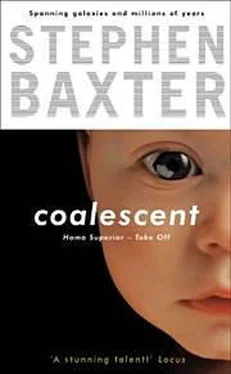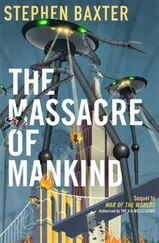That wasn’t as simple as it sounds. The structure of the place internally was very complicated, with floors and partition walls and bits of mezzanines all over the place, and we had to walk sometimes hundreds of yards from one staircase to the next. Everything was bathed in a pearly, sourceless fluorescent glow, and looked the same in every direction. As I got turned this way and that I was soon lost. But that was probably intentional; inside the Crypt you weren’t supposed to know where you were.
Still, it soon became clear that we had passed below what I had roughly labeled as Level 1, the uppermost, most modern-looking area of the Crypt, where schoolchildren studied purposefully and the scrinarii worked amid their computers and card indices and steel library shelves. It was a big place; Level 1 was actually several stories and mezzanines. Now we clambered down steel staircases into the heart of the level below, Level 2, which I had only glimpsed before from the mezzanine levels above.
The furniture, partitions, ceiling tiles, lighting, and other equipment were modern, just as above. Nevertheless there was a different atmosphere down here. The corridors seemed narrower, lower, more confining, darker, while most of the chambers were big — if not huge — mighty, open cubicula each of which could have held hundreds of people. The businesses of the Order, like the genealogy service, were run from Level 1, but most of the rooms down here were given over to functions that served more basic needs. I was shown an immense hospital, equipped with modern gear but oddly open-plan, a refectory the size of an aircraft hangar, and dormitories in which rows of bunk beds, jammed close in together, marched into the distance.
I never saw a room empty, anywhere in the Crypt, and so it was here. The hospital seemed to have few patients, but swarmed with activity. People were sleeping in some of the dormitories, even in midmorning, perhaps night-shift workers tucked into their bunk beds like rows of insect pupae in their cocoons. The corridors, too, were always packed with people, squeezing to and fro on their endless chores.
Crowding around me, they would touch, squeeze past, smile just as politely as above, and I saw the same faces, the family face, as I thought of it now, with low cheekbones, pale gray eyes. But the denizens of Level 2 had a slightly different look about them. Many were very pale, and they seemed to have exaggerated features — large, flaring nostrils, big eyes, even prominent ears. They were all a similar size, smaller than either Rosa or me. Compact, to fit into a compact space, I thought idly. They weren’t freaks. None of them would have looked out of place in one of Rome’s ancient piazzas. But cumulatively, there was an impression of subtle difference, even from the level above.
And few of them talked. Oddly, it took me a while to notice that. But there was little of the incessant chatter of Level 1. Here, there were words exchanged, brief conversations, but no hubbub. It was, I thought, as if words weren’t really needed here.
It struck me that I had already come deeper than most members of the public, like the schoolchildren in their classrooms above, would ever reach. Nobody would see this — nobody but another member of the Order — and to her, who had grown up with it, none of this would seem strange at all.
And the air was thicker, warmer, and more redolent with that earthy animal musk. I soon felt breathless; my chest strained as I breathed, my lungs ached. After a time I began to feel sleepy, and I had a vague sense of the Crypt and its inhabitants swimming past me, as if I were in a waking dream.
I struggled to think.
“Most people born in the Crypt stay here. Is that true?”
“Not all,” Rosa said. She talked about how people would be sent “outside,” for a day, a month, even years, during their education, or as part of their work. “Like Lucia. And some leave for good, like our own grandmother—”
“Grannie?”
“She was born here, but died in Manchester. You didn’t know that, did you? How do you think families like ours, branches of Regina’s ancient clan, end up in England, or America, or elsewhere? Of course people leave — they always have — sometimes for good. But they retain a loyalty to the Order.” She smiled. “It’s our shared heritage, after all.”
There was a lot I never learned about the Order — how they allocated their children surnames, for instance. I wondered vaguely how babies born here were formally registered, whether the Order had some tame functionary in Rome’s registry of births and deaths. Perhaps some of them grew up here without any official record at all, never leaving the Crypt, living and dying invisible to the state.
Rosa brought me to a kind of open oven, a brick-lined niche in the wall taller than I was. I lingered, curious. A wide chimney snaked up out of sight, caked with soot. There was no fire burning. This was very old — I recognized narrow Empire-era red bricks, the thick-packed mortar between them.
“So what’s this, a barbecue?”
Rosa smiled. “Part of our ventilation system. Or it was. Nowadays we have modern air-conditioning equipment — ducts, pumps, fans, dehumidifiers, even carbon dioxide scrubbers. But that kind of gear has only become available in the last few decades or so. In the eighteenth century we did buy one of James Watt’s first steam engines, but that was deinstalled and sold off to a museum long ago … The very first builders, digging down from the Catacombs, adapted techniques used in the deep mines. You’d light a fire under here and keep it burning, all day.” She pointed upward. “The smoke and heat would rise up the chimney — and, rising, would draw air through the Crypt. Elsewhere there are vents to allow more air in. Sometimes they would work bellows.”
“So you’d get a circulation. Ingenious.”
“In case of problems with the airflow, the Order members would have to block a corridor or passageway.”
“With what?”
“With their bodies, of course. They’d just run to where the problem was. It sounds crude, but it worked very well.”
“Who told them what to do?”
She seemed puzzled by the question. “Why, nobody. You’d look around, see there was a problem, follow your neighbors, do what they were doing. Just as if you were putting out a fire. You don’t need to be told to do that, do you? You just do it …”
I had no reason to disbelieve her. I had still seen no senior management floor, no corner offices for the Big Cheeses, no evidence of a chain of command. Evidently things just worked, the way Rosa had described.
She was still talking about the ventilation system. She slapped the solid brick wall. “The old infrastructure is still there. Always will be. Even now — though we have our own generators, like a hospital, independent of the public supply — we prepare for power outages. The youngsters are still taught about the old ways, given simple drills. If the very worst happened, we could always revert to the old methods.”
I peered at the ancient brickwork. “The very worst? …”
“If everything fell apart. If there was no more power at all.”
That took me aback. “You’re planning for how to keep the air supply functioning, even if civilization falls. ”
“Not planning, exactly. There are few plans here, George. But — well, we’re here for the long term. And you read Regina’s story. Civilizations do sometimes inconveniently fall …”
We walked on, down the crowded corridor. She led me away from the ancient hearth, down further staircases — some of them metal, some of them older, cut from the stone itself — staircases that led ever deeper into the core of the Crypt.
Читать дальше












